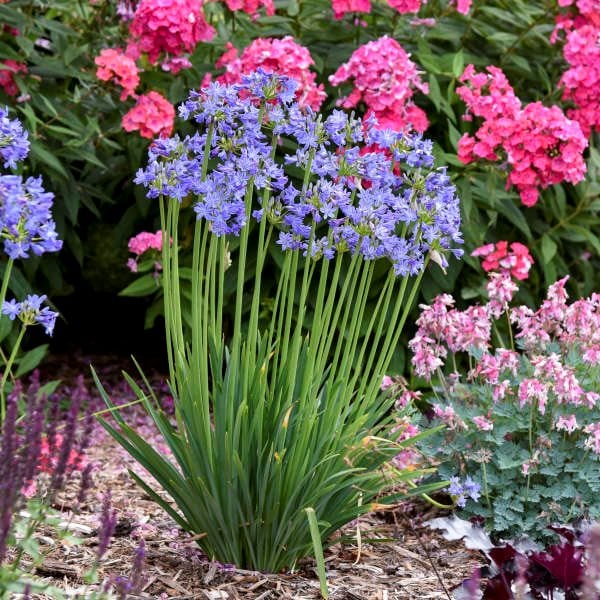Mastering the Art of Agapanthus Treatment: Necessary Actions for Healthy Growth and Dynamic Blossoms
In the realm of horticulture, the growing of agapanthus stands as a satisfying undertaking for those that look for to support these classy blooming plants. From choosing the right range to mastering pruning strategies, the journey towards growing prospering agapanthus plants is diverse and holds the essential to unlocking the full potential of these herb gems.

Choosing the Right Agapanthus Selection

When picking the right Agapanthus variety for your garden, think about elements such as environment suitability, flower color, and development behavior. Agapanthus, typically referred to as Lily of the Nile or African lily, is available in a selection of shades varying from shades of purple and blue to white. Choose a flower shade that enhances your existing yard combination to create a harmonious landscape. Furthermore, think about the climate in your region to guarantee the Agapanthus range you choose can flourish in your particular problems. Some selections are extra forgiving of chilly temperatures, while others like warmer environments. Comprehending the growth habit of various Agapanthus selections is crucial for proper positioning within your garden. Some ranges have a clumping growth behavior, suitable for containers or boundaries, while others have a more spreading nature, ideal for ground cover or mass plantings. By meticulously reviewing these aspects, you can select the perfect Agapanthus range to enhance the beauty of your yard.
Perfect Planting Problems
Thinking about the optimum ecological demands is essential for successful Agapanthus farming. Agapanthus flourishes in well-draining soil with a somewhat acidic to neutral pH level. When growing, pick a place that receives complete sunshine to partial shade. In hotter environments, giving some afternoon color can prevent scorching of the leaves. Agapanthus plants are sensitive to cool temperatures and must be protected from frost throughout winter season.
To guarantee healthy growth and dynamic blossoms, plant Agapanthus light bulbs at a deepness of concerning 2-4 inches and area them 8-12 inches apart. Adding raw material, such as compost, to the soil can improve drain and fertility, advertising durable origin growth. Mulching around the base of the plants aids preserve dampness and reduces weed development. Normal watering is essential, particularly during the expanding period, to maintain the soil regularly moist however not saturated.
Watering and Feeding Tips
Maintaining correct moisture levels and providing vital nutrients are essential aspects in the treatment regimen for Agapanthus plants. When it comes to watering Agapanthus, it is vital to strike an equilibrium. These plants choose constantly wet soil however are at risk to root rot if overwatered.
Fertilizing Agapanthus is necessary for advertising healthy and balanced growth and prolific flowers. Apply a well balanced plant food, such as a 10-10-10 formula, in the early spring as brand-new development emerges. Repeat this application every 6-8 weeks throughout the growing season. Prevent excessive fertilizing, as it can bring about lush foliage at the expense of flowers. Always follow the manufacturer's instructions for appropriate dilution and application methods. By following these watering and fertilizing suggestions, you can ensure your Agapanthus plants thrive and create lively, long-lasting blooms.
Pruning Methods for Agapanthus
Trimming Agapanthus plants at the proper times and with appropriate techniques is crucial for maintaining their health and wellness and promoting optimal development and blooming. The suitable time to prune Agapanthus is in late winter go right here or very early spring before new development arises.
For flowered stems, wait until the blooms have perished and then cut them back to the base. This not only tidies up the plant's look however also urges the advancement of new blossom buds. Deadheading spent blossoms can also reroute the plant's energy right into creating even more flowers instead than setting seeds. However, if you intend to accumulate seeds for breeding, leave some blossoms to completely dry and mature on the plant.
Bear in mind to use tidy, sharp tools to make specific cuts and decrease the danger of presenting illness. Agapanthus. Regular pruning will certainly help keep your Agapanthus looking healthy and balanced and cool while making sure a plentiful screen of lovely blooms
Handling Common Bugs and Illness
After guaranteeing appropriate pruning methods for Agapanthus, it is necessary to resolve usual pests and diseases that can influence the wellness and vigor of these plants. One typical parasite that influences Agapanthus is the Agapanthus gall midget.
One more common problem is fungal leaf spot, which presents as dark sores on the fallen leaves. To stop fungal conditions, ensure good air blood circulation around the plants, prevent overhanging watering, and eliminate any infected fallen leaves promptly. Additionally, Agapanthus plants can experience root rot if they are planted in inadequately draining dirt. To avoid this, plant Agapanthus in well-draining soil and stay clear of overwatering. By being cautious and taking punctual action against conditions and insects, you can help your Agapanthus plants grow and create vivid flowers.
:strip_icc()/snow-storm-agapanthus-18f19b9a-3e7c6c88441b4127a9015f9a9fecec59.jpg)
Final Thought
To conclude, understanding the art of agapanthus care includes choosing the ideal range, giving optimal growing problems, appropriate watering and feeding, ideal trimming methods, and resolving typical parasites and conditions. By complying with these essential steps, you can ensure healthy development and vivid blossoms for your agapanthus plants. Bear in mind to on a regular basis monitor and maintain your plants to advertise their total wellness and long life.
To make sure healthy growth and vivid blooms, plant Agapanthus bulbs at pop over to these guys a deepness of concerning 2-4 next inches and area them 8-12 inches apart. By following these watering and fertilizing pointers, you can guarantee your Agapanthus plants flourish and produce vibrant, long-lasting blooms.
One usual bug that impacts Agapanthus is the Agapanthus gall midge. Additionally, Agapanthus plants can endure from origin rot if they are planted in inadequately draining pipes soil. By following these important actions, you can make sure healthy development and vivid flowers for your agapanthus plants.